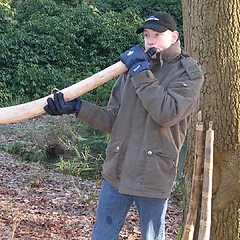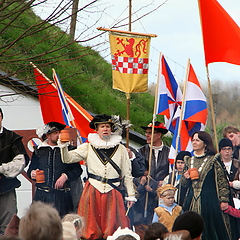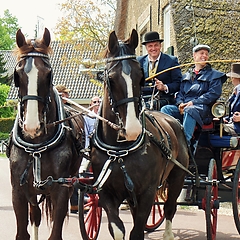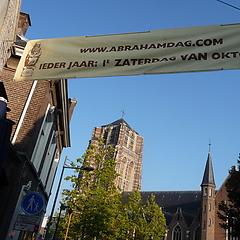The bonfire has its roots in the illegal Christmas tree burnings in various neighbourhoods of Scheveningen in the forties and fifties of the last century. During rausen, the term for gathering Christmas trees, mutual disputes among neighbourhoods were fought out as well. However, the social aspect was actually very important. Young people went out hunting Christmas trees together and tried to trump other neighbourhoods by making their fires bigger and bigger. Neighbour residents met at the construction of the stack and the sense of togetherness was strong. Fights, burglaries and vandalism made the municipality of The Hague prohibit the various bonfires. The city council then suggested to the neighbourhoods to build a common fire, on the Noorderstrand. The Scheveningers reluctantly consented, under the condition that the fire could be as high as possible. The battles were replaced by an organised competition on the beach. It became a contest for the ‘highest fire’ between the only two remaining bonfires in Scheveningen: Noorderstrand, (Scheveningen Village) and the Zuiderstrand (the southern part of the beach) of the city quarter called Duindorp in Scheveningen.
Description
Community
For Scheveningen working on the bonfire has the character of a reunion. Children are involved in the bonfire at a very early age. The bonfire attracts more and more visitors in recent years, and tourists as well. Within the framework of the safety plan, the organisers keep in close contact with the municipality of The Hague, the police and the fire department.
History
The bonfire has its roots in the illegal Christmas tree burnings in various neighbourhoods of Scheveningen in the forties and fifties of the last century. During rausen, the term for gathering Christmas trees, mutual disputes among neighbourhoods were fought out as well. However, the social aspect was actually very important. Young people went out hunting Christmas trees together and tried to trump other neighbourhoods by making their fires bigger and bigger. Neighbour residents met at the construction of the stack and the sense of togetherness was strong. Fights, burglaries and vandalism made the municipality of The Hague prohibit the various bonfires. The city council then suggested to the neighbourhoods to build a common fire, on the Noorderstrand. The Scheveningers reluctantly consented, under the condition that the fire could be as high as possible. The battles were replaced by an organised competition on the beach. It became a contest for the ‘highest fire’ between the only two remaining bonfires in Scheveningen: Noorderstrand, (Scheveningen Village) and the Zuiderstrand (the southern part of the beach) of the city quarter called Duindorp in Scheveningen.
Safeguarding
2024-2026
- There is an agreement to allow groups of young people to work under adult supervision, this has been included in the licence application and approved.
- As the event continues to grow, an eye is kept on where collaboration with other organizations is desired.
- The group arranging sponsorship is being expanded
- One continues to inform local residents about the activities that will take place.
- Where necessary, cooperation is sought with event agencies that can assist with permit applications.
- New generations are included in the organization; a script is available for this purpose, which is updated annually.
2020-2023
- Continue to communicate PR and awareness to the general public: participate in TV interviews, newspaper articles, documentaries. Communicate that several universities are researching nitrogen emissions and that the results were negligible. Received exemption for this.
- Keeping attention to safety, communicating this mainly verbally. Organize three walk-in evenings for the builders to transfer knowledge to create a safe event.
- Keep track of what appears in the media (the sensible things, not the nonsense) and that will be put on the website.
- Let the board get more experience in applying for a permit. In time this should be possible without expensive experts.
- Attention to ARBO law and regulations. Do not allow builders/young people without PPE (personal protective equipment) on the "construction site" anymore. Also no letting young people under 16 years old do the work to be done. This was included in the permit application and approved.
- Purchasing more PPE. Finding ways to get finances
2015-2019
- Staying in conversation with the municipality of The Hague to be able to put up the best possible edition of the Bonfire for all parties involved.
- Keep looking for new volunteers who can and want to support the organization.
- Continue to look for subsidies so that the volunteers no longer have to take unpaid leave. This will help ease the workload of the volunteers.
- Always remain on the lookout for new volunteers.
- Looking at additional safety measures and coordinate this with the municipality of The Hague.
Contact
Vreugdevuur Scheveningen NoorderstrandWebsite



